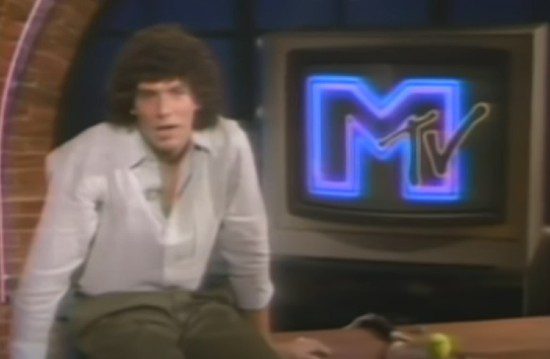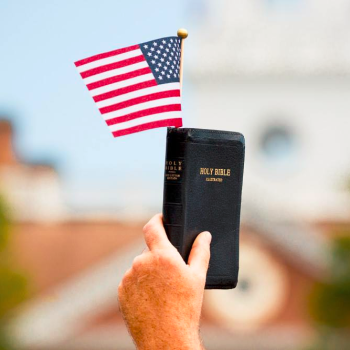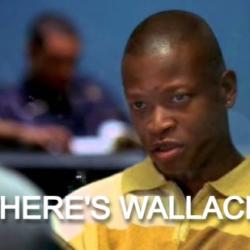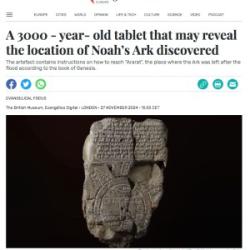Here’s an interview with historian Randall Balmer about his new book, Bad Faith: Race and the Rise of the Religious Right.
The story Balmer recounts and documents there is not an exposé revealing secrets never before made public. Nor is it arcana about the distant past unearthed in some musty archive. This was a story that unfolded publicly. It was on television and in all the newspapers. Balmer is a historian, but he is also a white evangelical who is now 66 years old, and so he remembers this story. I’m 53, so I do too.
Everyone our age who lived in that evangelical world during the 1970s and the 1980s remembers this story,* even — and probably especially — those most aggressively pretending they don’t. After all, it takes far more attention and focus to avoid looking at the elephant in the room than it does to acknowledge its presence.

That’s a bitter running joke about Randall Balmer’s work on this subject. Angry white Christians who feel compelled to dismiss his formidably documented argument try to label him as an obsessive crank going on about his hobby horse. That’s comical because, yes, he’s written many articles and books on the segregationist/anti-civil-rights roots of the religious right, and he’s lectured on it in classrooms for years, but he’s also written about many other subjects. And he’s free to spend most of his life and most of his time doing other things.
He’s free to have free time, in other words, in exactly the way that those angry white critics are not. Because, again, looking at what’s sitting right there in front of all of us takes far less work than avoiding ever seeing it. Refusing to see it is a full-time job requiring perpetual, constant vigilance 24/7/365. For years. Even once you’ve developed mechanisms and honed the skills and habits of not seeing, you can never let your guard down and relax. You must always be on the lookout for what you’re determined not to look at.
Yonat Shimron summarizes part of what it is that most white evangelicals are refusing to look at and pretending they don’t remember:
Specifically, as Balmer shows, it was government interference in “segregation academies” such as Bob Jones University in Greenville, South Carolina, that launched the religious right. Bob Jones and other schools, such as Jerry Falwell’s Lynchburg Christian Academy, refused to admit Black students. As a result, President Richard Nixon ordered the Internal Revenue Service to deny them tax-exempt status as a charitable institution.
In 1971, the Supreme Court agreed. In Green v. Connally, the court held that racially discriminatory schools are not entitled to a tax exemption. (Bob Jones University had its tax-exempt status revoked in 1976.)
White evangelicals were furious. But they could not organize politically by defending racial segregation. Instead, conservative political activists such as Paul Weyrich and Richard Viguerie landed on opposition to abortion as a more “high-minded defense” for their movement, Balmer writes.
That took a while. As Balmer shows, when the Supreme Court legalized abortion, few white evangelicals had anything bad to say about abortion. Baptists such as W.A. Criswell, the former president of the Southern Baptist Convention and pastor of First Baptist Church in Dallas, applauded the ruling. But by the election of Ronald Reagan in 1980, the strategy began to bear fruit.
I was 12 in 1980 and I remember the unanimous and wildly enthusiastic support for Reagan in that election, shared by everyone at our white fundamentalist church and private school. None of that enthusiasm had anything to do with abortion. It was Cold War Christian nationalism, frustration over the energy crisis and the hostages in Iran, and a dozen different Atwater-esque euphemisms disguising the real reasons that we, as white evangelical Christians, were abruptly joining Jesse Helms and Strom Thurmond as suddenly hyper-partisan Republicans.
And if you’re old enough to remember the 1980s, then you also remember that the ret-conning of our partisan realignment as something due to abortion took the rest of the decade to really catch on. It wasn’t until much later that we developed the “But the Supreme Court!” trump-card excuse (which made no sense at the time with appointments like O’Connor and Souter). And throughout the ’80s, there remained a huge distance between most white evangelicals preferences and rhetoric about abortion and those of groups like Operation Rescue or the American Life League. Their hard line of “it’s murder from the moment of conception” was regarded as lunatic-fringe nuttery by most anti-abortion white evangelicals well into the ’90s.
Randall Balmer remembers this. So do I. That doesn’t make us exceptional because every white evangelical who lived through those years remembers this too. Or they would if they allowed themselves to do so, or if they weren’t sure that others wouldn’t allow it.
“You’re not allowed to remember” is the theme of Ramesh Ponnuru’s National Review column refusing to look at the facts and the documented history and the undeniable record that Randall Balmer collects in his book. Ponnuru squints his eyes shut and jams his fingers in his ears, chanting “Lalala I can’t hear you” and mocking Balmer’s history and living memory as “A Nutty Conspiracy Theory About Pro-Lifers.”
And that is, again, something he wrote for the National Review. I invite Ponnuru, and anyone else who cares to do so, to sift through the archives of that magazine from, say, 1961 through 1981. Make two columns: One for every mention of legal abortion and another for every mention of integration and/or the full legal and civil equality of Black people. Can you guess which will prove to be the larger factor and the greater priority for this key platform of American conservatism?
Let me remind us again of “Christianity and Democracy” — Richard John Neuhas’ 1981 manifesto for the intellectual wing of the still-new religious right:
Here’s the editors of the belligerently conservative journal First Things, describing early 1980s white Christian support for Reagan in 1996: “At that time the Cold War was the dominant fact in international affairs and largely shaped domestic politics.” That’s from the introduction to the journal’s reprinting of its founder’s 1981 manifesto “Christianity and Democracy” on its 15th anniversary. That essay never mentions abortion politics. Or abortion. At all. It argues, rather, that anti-communism ought to be the No. 1 priority for good white Christian voters, and that anything else is a dangerous and irresponsible distraction from that paramount concern.
Nobody indignantly condemned Richard John Neuhaus in 1981 for failing to mention the moral horror white evangelicals were experiencing after years of legal abortion had forced them to confront the new reality of millions of “murdered babies.” Because that moral horror hadn’t yet been conjured up.
In 1981, the framework of the Cold War still provided the emotional reassurance that anti-civil-rights white conservatives desperately needed in order to be able to look at themselves in the mirror. They wanted and needed to imagine themselves as good people and yet they were actively and daily failing the largest and most obvious moral test of their day. The Cold War provided a pretense of binary moral absolutes: Good Guys vs. Bad Guys. And thus all one needed to reassure oneself of one’s own apparent goodness was to stake out a position on the side of the Good Guys. This had been white conservatives’ go-to emotional strategy ever since the 1950s, labeling lunch-counter protesters and Rosa Parks and MLK as “communists” and therefore as the Bad Guys — making us, therefore, the Good Guys and good people.
By 1996, that framework was no longer capable of satisfying our emotional need to imagine ourselves as good. The Cold War was over. Ronald Reagan himself had signed a law making Martin Luther King’s birthday a national holiday. Anti-communism was no longer an effective tool for quieting the gnawing realization that we have not been and are not now the Good Guys in this story.
And so, somewhere in those intervening years, in between 1981 and 1996 — gradually, and then all at once — we switched to a different mechanism for quieting that anxiety and a different pretense allowing us to deceive ourselves into imagining we’re the heroic Good Guys.
I remember this. If you were there, you remember it too, even if your need to preserve your current status within white evangelical churches or institutions won’t allow you to admit that.
* A few years back I wrote about the living memory of this history in a post with the overlong title “The con-game of anti-abortion partisanship that replaced Christianity has been so successful that we forget how recently it was invented.” That included this riff:
This entire construct — this bamboozling shtick — was concocted and created and adopted in my lifetime. It’s a new thing, younger than the Happy Meal. This isn’t ancient history, it’s living memory for Generation X.
It is a curious thing to learn that the highest ethical priority, this supposed bedrock of evangelical ethics and of identity, did not even exist when the first four Ramones albums came out. Or, to put it in friendlier terms for white evangelicals, when the first four Second Chapter of Acts albums came out.
And if you’re old enough to remember those albums, you’re old enough to remember this too. Whether you were singing along to “Rockaway Beach” or to “Mansion Builder,” you remember a time when white evangelicals were not bound by this moral hierarchy, when they would have found it bewildering.
Linking back to that because it’s apt and because it’s a good excuse to share this:
















